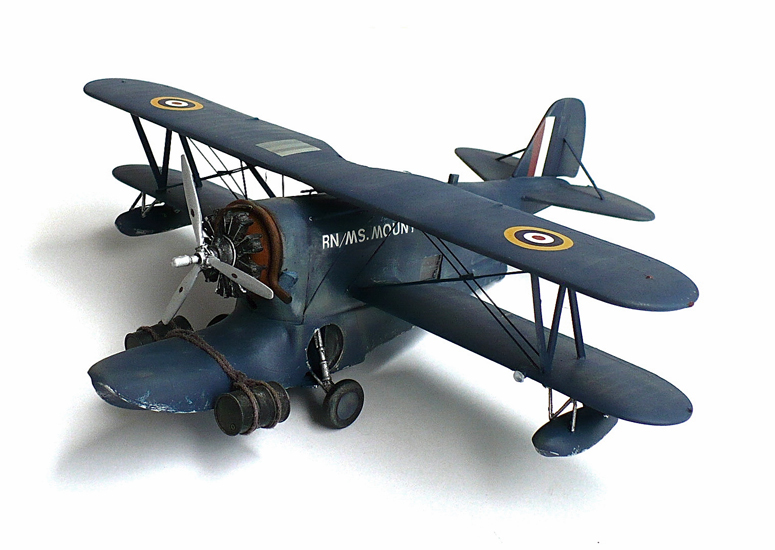Here are some images of Classic Airframe's 1/48 scale Grumman AO - 12 Duck from the movie "Murphy's War".
From Wikipedia"
The Grumman J2F Duck (company designation G-15) was an American single-engine amphibious biplane. It was used by each major branch of the U.S. armed forces from the mid-1930s until just after World War II, primarily for utility and air-sea rescue duties. It was also used by the Argentine Navy,
who took delivery of their first Duck in 1937. After the war, J2F Ducks
saw service with independent civilian operators, as well as the armed
forces of Colombia and Mexico.
The J2F was an improved version of the earlier JF Duck, with its main difference being a longer float.
The J2F-1 Duck first flew on 2 April 1936, powered by a 750 hp (559 kW) Wright R-1820 Cyclone, and was delivered to the U.S. Navy
on the same day. The J2F-2 had a Wright Cyclone engine which was
boosted to 790 hp (589 kW). Twenty J2F-3 variants were built in 1939 for
use by the Navy as executive transports with plush interiors. Due to
pressure of work following the United States entry into the war in 1941, production of the J2F Duck was transferred to the Columbia Aircraft Corp of New York. They produced 330 aircraft for the Navy and U.S. Coast Guard.
If standard Navy nomenclature practice had been followed, these would
have been designated JL-1s, but it was not, and all Columbia-produced
airframes were delivered as J2F-6s.
Several surplus Navy Ducks were converted for use by the United States Air Force in the air-sea rescue role as the OA-12 in 1948.
The J2F was an equal-span single-bay biplane with a large monocoque central float which also housed the retractable main landing gear, a similar design to the Leroy Grumman-designed landing gear first used for Grover Loening's early amphibious biplane designs, and later adopted for the Grumman FF fighter biplane. The aircraft had strut-mounted stabilizer floats beneath each lower wing. A crew of two or three were carried in tandem cockpits, forward for the pilot and rear for an observer with room for a radio operator if required. It had a cabin in the fuselage for two passengers or a stretcher.
The Duck's main pontoon was blended into the fuselage, making it almost a flying boat
despite its similarity to a conventional landplane which has been
float-equipped. This configuration was shared with the earlier Loening OL, Grumman having acquired the rights to Loening's hull, float and undercarriage designs. Like the F4F Wildcat, its narrow-tracked landing gear was hand-cranked.
The J2F was used by the U.S. Navy, Marines, Army Air Forces and Coast Guard. Apart from general utility and light transport duties, its missions included mapping, scouting/observation, anti-submarine patrol, air-sea rescue work, photographic surveys and reconnaissance, and target tug.
J2Fs of the utility squadron of US Patrol Wing 10 were destroyed at Mariveles Bay, Philippines, by a Japanese air raid on 5 January 1942. The only Duck to survive the attack had a dead engine but had been concealed at Cabcaben airfield during the Battle of Bataan,
to be repaired afterwards with a cylinder removed from a destroyed
J2F-4 submerged in Manila Bay. Following repairs the J2F-4 departed
after midnight on 9 April 1942, overloaded with five passengers and the
pilot, becoming the last aircraft to depart Bataan before the surrender
of the Philippines to the Japanese only hours later. Among its
passengers was Carlos P. Romulo
(diplomat, politician, soldier, journalist and author) who recounted
the flight in his 1942 best-selling book "I Saw the Fall of the
Philippines" (Doubleday, Doran & Company, Inc., Garden City, New
York 1943, pp. 288–303) for which he received the Pulitzer Prize for Correspond
The United States Coast Guard worked with North South Polar, Inc. to recover a J2F-4 Duck BUNO V-1640 downed in a storm on a Greenland glacier.
Two Coast Guard airmen were lost along with a rescued US Army Air Force
passenger from a downed B-17 searching for a downed C-53 with five on
board.
The three men of the Duck are presumed to still be entombed at the
site. North South Polar, under the auspices of the US Coast Guard team,
located the aircraft in August 2012 resting 38 feet beneath the surface
of the ice
sheet. As per the mandate of Title 10 of the US Code, North South Polar,
the US Coast Guard and the Joint POW/MIA Accounting Command plan to
recover the men's remains for proper interment. The Coast Guard and
North South Polar are also developing plans to recover the aircraft and
restore it to flying condition as a memorial to the aircrew. www.nspolar.us
Noted aircraft collector Kermit Weeks
has been the top Duck owner since World War II, owning as many as four.
Two of Weeks' J2Fs were traded for other aircraft, one is under
restoration, and the fourth is flyable and on display at Fantasy of Flight in Polk City, Florida.







No comments:
Post a Comment